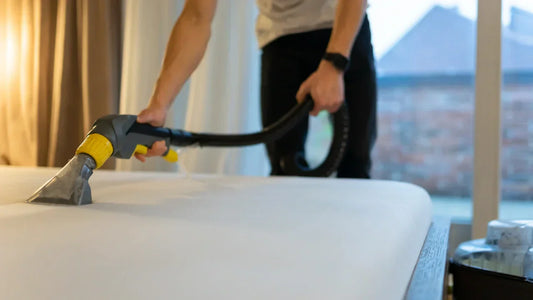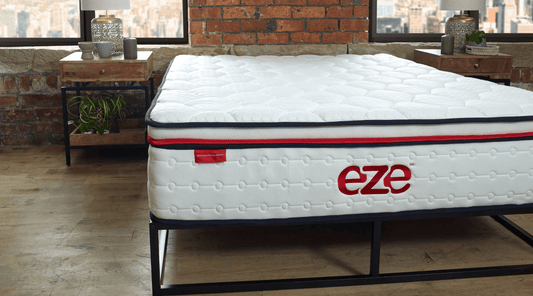Thinking of buying a memory foam mattress? Or curious about how they work?
You’re in the right place.
In this guide, we’ll cover:
-
What a memory foam mattress is and how it works
-
The pros and cons of memory foam mattresses
-
Alternatives you might want to consider
If you're ready to explore your mattress options, be sure to check out our collection of hybrid mattresses that use memory foam technology.
Quick Summary
-
Memory foam is a pressure-relieving material originally designed by NASA.
-
It moulds to your body and absorbs movement.
-
Great for side sleepers, couples, and people with joint pain.
-
Can sleep warm and be hard to move on.
-
Hybrid mattresses combine memory foam comfort with spring support and better airflow.
What Is Memory Foam?
Memory foam is a soft material that changes shape when you press on it before slowly returning to normal.
(If you’re into science, memory foam is a special type of viscoelastic polyurethane foam. It’s designed to respond to pressure and temperature.)
Unlike regular foam, which squashes and bounces back, memory foam moulds to the shape of your body first.
It was actually invented by NASA in the 1960s to make spacecraft seats safer and more comfortable.
Today, it’s one of the most popular mattress materials because it can adapt to your body and offer amazing support.
Key features of memory foam:
-
Viscoelasticity: It’s both stretchy and springy, so it changes shape under pressure but slowly returns afterwards.
-
Temperature sensitivity: It softens when it gets warmer (like from your body heat).
-
Contouring ability: It moulds to your shape and spreads your weight evenly.
-
Slow recovery: It takes a few seconds to spring back when pressure is removed.
What Is Memory Foam Made Of?
Ready for a mini science lesson?
Memory foam is made mainly from a type of plastic called polyurethane.
To give it its special squishy feel, manufacturers add extra chemicals called additives. These control how soft, stretchy, or heat-sensitive the foam becomes.
Some of the key ingredients include:
-
Isocyanates (like MDI or TDI) – react with other chemicals to create the foam.
-
Polyols – liquid ingredients that help form the foam structure.
-
Blowing agents – create tiny air bubbles inside the foam to make it light and airy.
How Is Memory Foam Made?
It all starts by mixing polyols and isocyanates with blowing agents and other chemicals.
As they react, they produce gas bubbles.
(Kind of like a cake rising in the oven).
The mixture expands into a soft, spongy block, cools down, and hardens.
Once it sets, manufacturers cut the foam into shapes ready for mattresses and pillows.
The tiny air pockets inside the foam help it mould to your body.
Incidentally, these pockets are also the reason memory foam mattresses tend to be warm, as the air pockets trap heat.
(But more on this later).
How Does Memory Foam Work?
When you lie down, your body heat softens the memory foam while your weight presses into it.
The heat and pressure combo make the foam contour around you, which spreads your weight and relieves pressure.
As you move, the foam slowly returns to its original shape, usually within about 5 to 10 seconds.
This ability to adapt to your body is what makes memory foam so comfortable for many sleepers.
Benefits of Memory Foam
So, now you know how memory foam works. But what are the actual benefits for sleepers?
Let's take a look at some of the main ones:
Pressure Relief and Spinal Alignment
Memory foam does an excellent job of spreading your weight across its surface.
The benefit of this is that it reduces pressure on the shoulders, hips, and knees.
This is great for side sleepers or people with joint pain.
It also helps keep your spine in a natural position, which can reduce back pain and stiffness over time.
And because memory foam absorbs movement so well, you’re less likely to feel a partner tossing and turning next to you!
Hypoallergenic Properties and Durability
Memory foam’s dense structure makes it harder for dust mites and allergens to settle in.
While no mattress is 100% allergen-proof, memory foam is usually a good choice for allergy sufferers.
A high-quality memory foam mattress can last 7–10 years.
It holds its shape longer than many traditional mattresses, making it a smart long-term investment.
Disadvantages of Memory Foam
Heat Retention
As we mentioned earlier, memory foam has air pockets which trap heat.
This can make it uncomfortable for people who get hot when they sleep.
To solve this, some modern memory foam mattresses now use gel-infused layers.
You can learn more about this on our cooling gel mattresses page.
Slow Responsiveness
Memory foam’s slow "hugging" feel can sometimes make it harder to move or change positions quickly.
If you’re a combination sleeper (someone who switches positions a lot), you might prefer a slightly firmer or faster-responding foam.
A great alternative for those who like the hugging feeling of memory foam but also want a firmer bed is a hybrid mattress.
Off-Gassing Odours
When you first unpack a new memory foam mattress, you might notice a chemical smell.
This is off-gassing.
It happens when tiny amounts of gas (called VOCs) are released as the foam adjusts to room temperature.
The smell is usually harmless and fades within a few days, but it can be unpleasant at first.
Weight and Mobility
Memory foam mattresses are usually heavier than traditional spring mattresses.
This can make them trickier to move, flip, or carry - something to keep in mind if you move house often or live alone.
Types of Memory Foam Mattresses
Traditional Memory Foam
This is the original memory foam.
They're great for pressure relief and motion isolation, but tend to trap more heat.
Gel-Infused Memory Foam
These mattresses feature cooling gel beads or layers that absorb heat, helping you sleep cooler.
They feel like traditional memory foam but stay a bit more temperature-neutral.
Open-Cell Memory Foam
This version has tiny internal air channels to boost airflow.
It still hugs your body like regular memory foam, but feels cooler and slightly more breathable.
Plant-Based Memory Foam
Some newer memory foams replace parts of the petroleum-based ingredients with plant-based oils.
This makes them more eco-friendly, less smelly, and more breathable.
Memory Foam vs. Normal Foam
Here’s a quick side-by-side comparison:
| Feature | Memory Foam | Normal Foam |
| Contouring | Precisely moulds to body shape | Limited contouring with immediate bounce-back |
| Pressure Relief | Superior pressure point reduction | Moderate to minimal pressure relief |
| Motion Transfer | Excellent isolation | Minimal to moderate isolation |
| Temperature | Can retain heat (unless modified) | Generally, more temperature-neutral |
| Durability | 7-10 years | 3-5 years |
| Cost | Higher | Lower |
| Recovery Time | Slow (5-10 seconds) | Immediate |
So, What About Hybrid Mattresses?
If you like the idea of memory foam’s comfort but worry about overheating, sinking too much, or feeling "stuck," a hybrid mattress could be the perfect middle ground.
Hybrid mattresses combine the benefits of memory foam and pocket springs for a perfect night's sleep.
-
The top layers are made from memory foam (sometimes gel-infused) for that soft, contouring feel.
-
The bottom layers have individually wrapped pocket springs for extra support, airflow, and a little bounce.
This design means you get:
-
The body-hugging comfort and pressure relief of memory foam
-
The sturdy support and better airflow of springs
-
Easier movement when changing positions at night
-
Less heat build-up compared to a full foam mattress
You can learn more about hybrid mattresses in our guide.
FAQ's
What is the point of memory foam?
The main goal of memory foam is to reduce pressure points, keep your spine aligned, and make sleep more comfortable. It’s helpful for people who share a bed, thanks to its amazing motion isolation.
What are the disadvantages of memory foam?
Some people find memory foam too warm, too slow to respond, or too heavy to move easily.
What is the difference between memory foam and normal foam?
Memory foam moulds to your body and returns slowly to its shape. Normal foam compresses and bounces back quickly. Memory foam usually offers better pressure relief and longer durability.
Is memory foam good for back pain?
Yes! Memory foam can support your spine properly while cushioning pressure points.
How long do memory foam mattresses last?
A good quality memory foam mattress typically lasts 7–10 years.
Higher-density foams usually last longer, though they can feel a bit firmer and warmer.
Rotating your mattress regularly can help it stay comfortable for longer.









